Treatment of Pharmaceutical Effluent Using Ultrasound-Based Advanced Oxidation for Intensified Biological Oxidation
Abstract
1. Introduction
2. Materials and Methods
2.1. Materials
2.2. Experimental Setup
2.2.1. Ultrasonic Horn
2.2.2. Biological Oxidation Setup
2.3. Methodology
2.3.1. Pretreatment Studies
2.3.2. Aerobic Oxidation
2.4. Analysis
3. Results and Discussion
3.1. Pretreatment Using US Reactor
3.1.1. Effect of Initial pH on COD Reduction Using Only US
3.1.2. Effect of Temperature on COD Reduction Using Only US
3.2. US + AOPs
3.2.1. US + KPS
3.2.2. US + H2O2
3.2.3. US + Fenton
3.2.4. US + Peroxone
3.2.5. Kinetic Studies
3.3. Toxicity Analysis
3.4. Biological Oxidation
3.4.1. Sludge Preparation
3.4.2. Conventional Biological Oxidation
3.4.3. Sludge Acclimatisation
3.4.4. Effect of Pretreatment on Biological Oxidation Using Acclimatised Sludge
3.5. A Comparative Analysis of the Various Treatment Strategies
4. Conclusions
Author Contributions
Funding
Institutional Review Board Statement
Data Availability Statement
Acknowledgments
Conflicts of Interest
References
- Naddeo, V.; Belgiorno, V.; Kassinos, D.; Mantzavinos, D.; Meric, S. Ultrasonic degradation, mineralization and detoxification of diclofenac in water: Optimization of operating parameters. Ultrason. Sonochemistry 2010, 17, 179–185. [Google Scholar] [CrossRef] [PubMed]
- Kerc, A.; Bekbolet, M.; Saatci, A.M. Effect of partial oxidation by ozonation on the photocatalytic degradation of humic acids. Int. J. Photoenergy 2003, 5, 497421. [Google Scholar] [CrossRef]
- Samal, K.; Mahapatra, S.; Hibzur Ali, M. Pharmaceutical wastewater as Emerging Contaminants (EC): Treatment technologies, impact on environment and human health. Energy Nexus 2022, 6, 100076. [Google Scholar] [CrossRef]
- Sakumoto, A.; Miyata, T. Treatment of waste water by a combined technique of radiation and conventional method. Radiat. Phys. Chem. (1977) 1984, 24, 99–115. [Google Scholar] [CrossRef]
- Luo, Y.; Guo, W.; Ngo, H.H.; Nghiem, L.D.; Hai, F.I.; Zhang, J.; Liang, S.; Wang, X.C. A review on the occurrence of micropollutants in the aquatic environment and their fate and removal during wastewater treatment. Sci. Total Environ. 2014, 473–474, 619–641. [Google Scholar] [CrossRef]
- An, T.; Yang, H.; Li, G.; Song, W.; Cooper, W.J.; Nie, X. Kinetics and mechanism of advanced oxidation processes (AOPs) in degradation of ciprofloxacin in water. Appl. Catal. B Environ. 2010, 94, 288–294. [Google Scholar] [CrossRef]
- Lin, D.; Fu, Y.; Li, X.; Wang, L.; Hou, M.; Hu, D.; Li, Q.; Zhang, Z.; Xu, C.; Qiu, S.; et al. Application of persulfate-based oxidation processes to address diverse sustainability challenges: A critical review. J. Hazard. Mater. 2022, 440, 129722. [Google Scholar] [CrossRef]
- Eren, Z.; Ince, N.H. Sonolytic and sonocatalytic degradation of azo dyes by low and high frequency ultrasound. J. Hazard. Mater. 2010, 177, 1019–1024. [Google Scholar] [CrossRef] [PubMed]
- Wang, L.; Luo, D.; Hamdaoui, O.; Vasseghian, Y.; Momotko, M.; Boczkaj, G.; Kyzas, G.Z.; Wang, C. Bibliometric analysis and literature review of ultrasound-assisted degradation of organic pollutants. Sci. Total Environ. 2023, 876, 162551. [Google Scholar] [CrossRef]
- Raut-Jadhav, S.; Badve, M.P.; Pinjari, D.V.; Saini, D.R.; Sonawane, S.H.; Pandit, A.B. Treatment of the pesticide industry effluent using hydrodynamic cavitation and its combination with process intensifying additives (H2O2 and ozone). Chem. Eng. J. 2016, 295, 326–335. [Google Scholar] [CrossRef]
- Lakshmi, N.J.; Iyer, A.M.; Gogate, P.R. Treatment of wastewater containing ciprofloxacin using the hybrid treatment approach based on acoustic cavitation. Can. J. Chem. Eng. 2024, 102, 2403–2417. [Google Scholar] [CrossRef]
- Méndez-Arriaga, F.; Torres-Palma, R.A.; Pétrier, C.; Esplugas, S.; Gimenez, J.; Pulgarin, C. Mineralization enhancement of a recalcitrant pharmaceutical pollutant in water by advanced oxidation hybrid processes. Water Res. 2009, 43, 3984–3991. [Google Scholar] [CrossRef]
- Al Momani, F.; Sans, C.; Esplugas, S. A comparative study of the advanced oxidation of 2,4-dichlorophenol. J. Hazard. Mater. 2004, 107, 123–129. [Google Scholar] [CrossRef] [PubMed]
- Saxena, S.; Rajoriya, S.; Saharan, V.K.; George, S. An advanced pretreatment strategy involving hydrodynamic and acoustic cavitation along with alum coagulation for the mineralization and biodegradability enhancement of tannery waste effluent. Ultrason. Sonochemistry 2018, 44, 299–309. [Google Scholar] [CrossRef]
- Chandak, S.; Ghosh, P.K.; Gogate, P.R. Treatment of real pharmaceutical wastewater using different processes based on ultrasound in combination with oxidants. Process Saf. Environ. Prot. 2020, 137, 149–157. [Google Scholar] [CrossRef]
- Antes, F.G.; Diehl, L.O.; Pereira, J.S.F.; Guimarães, R.C.L.; Guarnieri, R.A.; Ferreira, B.M.S.; Dressler, V.L.; Flores, E.M.M. Feasibility of low frequency ultrasound for water removal from crude oil emulsions. Ultrason. Sonochemistry 2015, 25, 70–75. [Google Scholar] [CrossRef] [PubMed]
- Antes, F.G.; Diehl, L.O.; Pereira, J.S.F.; Guimarães, R.C.L.; Guarnieri, R.A.; Ferreira, B.M.S.; Flores, E.M.M. Effect of ultrasonic frequency on separation of water from heavy crude oil emulsion using ultrasonic baths. Ultrason. Sonochemistry 2017, 35, 541–546. [Google Scholar] [CrossRef]
- Shajeelammal, J.; Mohammed, S.; Prathish, K.P.; Jeeva, A.; Asok, A.; Shukla, S. Treatment of real time textile effluent containing azo reactive dyes via ozonation, modified pulsed low frequency ultrasound cavitation, and integrated reactor. J. Hazard. Mater. Adv. 2022, 7, 100098. [Google Scholar] [CrossRef]
- Zampeta, C.; Bertaki, K.; Triantaphyllidou, I.-E.; Frontistis, Z.; Vayenas, D.V. Treatment of real industrial-grade dye solutions and printing ink wastewater using a novel pilot-scale hydrodynamic cavitation reactor. J. Environ. Manag. 2021, 297, 113301. [Google Scholar] [CrossRef]
- Al-Juboori, R.A.; Hilal, N. Pharmaceuticals removal from wastewater: Ultrasound technology and its potential amalgamation with membrane processes. J. Water Process Eng. 2023, 53, 103810. [Google Scholar] [CrossRef]
- Iyer, A.M.; Lakshmi, N.J.; Gogate, P.R. Intensified Biological Oxidation of Ciprofloxacin using Acoustic Cavitation based Pretreatment. Environ. Qual. Manag. 2025, 34, e70030. [Google Scholar] [CrossRef]
- ISO 15705:2002; Water Quality—Determination of the Chemical Oxygen Demand Index (ST-COD)—Small-Scale Sealed-Tube Method. International Organization for Standardization: Vernier, Geneva, Switzerland, 2021.
- Wei, Z.; Spinney, R.; Ke, R.; Yang, Z.; Xiao, R. Effect of pH on the sonochemical degradation of organic pollutants. Environ. Chem. Lett. 2016, 14, 163–182. [Google Scholar] [CrossRef]
- Naddeo, V.; Meriç, S.; Kassinos, D.; Belgiorno, V.; Guida, M. Fate of pharmaceuticals in contaminated urban wastewater effluent under ultrasonic irradiation. Water Res. 2009, 43, 4019–4027. [Google Scholar] [CrossRef]
- Saharan, V.K.; Badve, M.P.; Pandit, A.B. Degradation of Reactive Red 120 dye using hydrodynamic cavitation. Chem. Eng. J. 2011, 178, 100–107. [Google Scholar] [CrossRef]
- Entezari, M.H.; Kruus, P. Effect of frequency on sonochemical reactions II. Temperature and intensity effects. Ultrason. Sonochemistry 1996, 3, 19–24. [Google Scholar] [CrossRef]
- Ince, N.H. Ultrasound-assisted advanced oxidation processes for water decontamination. Ultrason. Sonochemistry 2018, 40, 97–103. [Google Scholar] [CrossRef]
- Al-Bsoul, A.; Al-Shannag, M.; Tawalbeh, M.; Al-Taani, A.A.; Lafi, W.K.; Al-Othman, A.; Alsheyab, M. Optimal conditions for olive mill wastewater treatment using ultrasound and advanced oxidation processes. Sci. Total Environ. 2020, 700, 134576. [Google Scholar] [CrossRef]
- Im, J.-K.; Heo, J.; Boateng, L.K.; Her, N.; Flora, J.R.V.; Yoon, J.; Zoh, K.-D.; Yoon, Y. Ultrasonic degradation of acetaminophen and naproxen in the presence of single-walled carbon nanotubes. J. Hazard. Mater. 2013, 254–255, 284–292. [Google Scholar] [CrossRef]
- Fedorov, K.; Sun, X.; Boczkaj, G. Combination of hydrodynamic cavitation and SR-AOPs for simultaneous degradation of BTEX in water. Chem. Eng. J. 2021, 417, 128081. [Google Scholar] [CrossRef]
- Daware, G.B.; Gogate, P.R. Intensified sonochemical degradation of 2-Picoline in combination with advanced oxidizing agents. Ultrason. Sonochemistry 2021, 77, 105702. [Google Scholar] [CrossRef]
- Daware, G.B.; Pangarkar, B.L.; Kayande, U.P.; Shinde, P.R.; Kolhe, M.J.; Dabhade, G.B.; Rajesh, Y.; Joshi, P.P. Intensified removal of 4-Methylpyridine by ultrasonication in presence of advanced oxidants. J. Indian Chem. Soc. 2023, 100, 100810. [Google Scholar] [CrossRef]
- Hou, S.; Ling, L.; Shang, C.; Guan, Y.; Fang, J. Degradation kinetics and pathways of haloacetonitriles by the UV/persulfate process. Chem. Eng. J. 2017, 320, 478–484. [Google Scholar] [CrossRef]
- Wu, Q. Wastewater Treatment by Enhanced H2O2—Based Advanced Oxidation Process (AOP) Methods: A Review. J. Phys. Conf. Ser. 2022, 2152, 012011. [Google Scholar] [CrossRef]
- Bokare, A.D.; Choi, W. Review of iron-free Fenton-like systems for activating H2O2 in advanced oxidation processes. J. Hazard. Mater. 2014, 275, 121–135. [Google Scholar] [CrossRef] [PubMed]
- Manikandan, P.; Palanisamy, P.N.; Baskar, R.; Sivakumar, P.; Sakthisharmila, P. Optimization of treatment efficiency of UV/H2O2 process on simulated textile industry wastewater. Desalination Water Treat. 2016, 57, 27169–27180. [Google Scholar] [CrossRef]
- Pradhan, A.A.; Gogate, P.R. Removal of p-nitrophenol using hydrodynamic cavitation and Fenton chemistry at pilot scale operation. Chem. Eng. J. 2010, 156, 77–82. [Google Scholar] [CrossRef]
- Pawar, V.; Gawande, S. An overview of the Fenton Process for Industrial Wastewater. J. Mech. Civ. Eng. 2015, 2, 127–136. [Google Scholar]
- Adityosulindro, S.; Barthe, L.; González-Labrada, K.; Jáuregui Haza, U.J.; Delmas, H.; Julcour, C. Sonolysis and sono-Fenton oxidation for removal of ibuprofen in (waste)water. Ultrason. Sonochemistry 2017, 39, 889–896. [Google Scholar] [CrossRef]
- Flyunt, R.; Leitzke, A.; Mark, G.; Mvula, E.; Reisz, E.; Schick, R.; von Sonntag, C. Determination of •OH, O2•-, and Hydroperoxide Yields in Ozone Reactions in Aqueous Solution. J. Phys. Chem. B 2003, 107, 7242–7253. [Google Scholar] [CrossRef]
- Ahmed, M.B.; Zhou, J.L.; Ngo, H.H.; Guo, W.; Thomaidis, N.S.; Xu, J. Progress in the biological and chemical treatment technologies for emerging contaminant removal from wastewater: A critical review. J. Hazard. Mater. 2017, 323, 274–298. [Google Scholar] [CrossRef]
- Li, Y.; Shen, W.; Fu, S.; Yang, H.; Yu, G.; Wang, Y. Inhibition of bromate formation during drinking water treatment by adapting ozonation to electro-peroxone process. Chem. Eng. J. 2015, 264, 322–328. [Google Scholar] [CrossRef]
- Ghanbari, F.; Zirrahi, F.; Lin, K.-Y.A.; Kakavandi, B.; Hassani, A. Enhanced electro-peroxone using ultrasound irradiation for the degradation of organic compounds: A comparative study. J. Environ. Chem. Eng. 2020, 8, 104167. [Google Scholar] [CrossRef]
- Dey, A.; Gogate, P.R. Comparative study of different ultrasound based hybrid oxidation approaches for treatment of real effluent from coke oven plant. J. Environ. Manag. 2024, 352, 120095. [Google Scholar] [CrossRef]
- Darsinou, B.; Frontistis, Z.; Antonopoulou, M.; Konstantinou, I.; Mantzavinos, D. Sono-activated persulfate oxidation of bisphenol A: Kinetics, pathways and the controversial role of temperature. Chem. Eng. J. 2015, 280, 623–633. [Google Scholar] [CrossRef]
- Son, H.-S.; Choi, S.-B.; Khan, E.; Zoh, K.-D. Removal of 1,4-dioxane from water using sonication: Effect of adding oxidants on the degradation kinetics. Water Res. 2006, 40, 692–698. [Google Scholar] [CrossRef]
- Somensi, C.A.; Simionatto, E.L.; Bertoli, S.L.; Wisniewski, A.; Radetski, C.M. Use of ozone in a pilot-scale plant for textile wastewater pre-treatment: Physico-chemical efficiency, degradation by-products identification and environmental toxicity of treated wastewater. J. Hazard. Mater. 2010, 175, 235–240. [Google Scholar] [CrossRef]
- Changotra, R.; Rajput, H.; Dhir, A. Treatment of real pharmaceutical wastewater using combined approach of Fenton applications and aerobic biological treatment. J. Photochem. Photobiol. A Chem. 2019, 376, 175–184. [Google Scholar] [CrossRef]
- Passatore, L.; Rossetti, S.; Juwarkar, A.A.; Massacci, A. Phytoremediation and bioremediation of polychlorinated biphenyls (PCBs): State of knowledge and research perspectives. J. Hazard. Mater. 2014, 278, 189–202. [Google Scholar] [CrossRef]
- Kamali, M.; Aminabhavi, T.M.; Tarelho, L.A.C.; Hellemans, R.; Cuypers, J.; Capela, I.; Costa, M.E.V.; Dewil, R.; Appels, L. Acclimatized activated sludge for enhanced phenolic wastewater treatment using pinewood biochar. Chem. Eng. J. 2022, 427, 131708. [Google Scholar] [CrossRef]
- Jiménez-Silva, V.A.; Santoyo-Tepole, F.; Ruiz-Ordaz, N.; Galíndez-Mayer, J. Study of the ibuprofen impact on wastewater treatment mini-plants with bioaugmented sludge. Process Saf. Environ. Prot. 2019, 123, 140–149. [Google Scholar] [CrossRef]
- Basheer, F.; Farooqi, I.H. Biodegradation of p-cresol by aerobic granules in sequencing batch reactor. J. Environ. Sci. 2012, 24, 2012–2018. [Google Scholar] [CrossRef] [PubMed]
- Alexander, M. Nonbiodegradable and Other Recalcitrant Molecules. Biotechnol. Bioeng. 1973, 15, 611–647. [Google Scholar] [CrossRef]
- Monteoliva-García, A.; Martín-Pascual, J.; Muñío, M.M.; Poyatos, J.M. Effects of carrier addition on water quality and pharmaceutical removal capacity of a membrane bioreactor—Advanced oxidation process combined treatment. Sci. Total Environ. 2020, 708, 135104. [Google Scholar] [CrossRef] [PubMed]
- Martínez, F.; Molina, R.; Rodríguez, I.; Pariente, M.I.; Segura, Y.; Melero, J.A. Techno-economical assessment of coupling Fenton/biological processes for the treatment of a pharmaceutical wastewater. J. Environ. Chem. Eng. 2018, 6, 485–494. [Google Scholar] [CrossRef]
- Gągol, M.; Przyjazny, A.; Boczkaj, G. Wastewater treatment by means of advanced oxidation processes based on cavitation—A review. Chem. Eng. J. 2018, 338, 599–627. [Google Scholar] [CrossRef]
- Segura, Y.; Cruz del Álamo, A.; Munoz, M.; Álvarez-Torrellas, S.; García, J.; Casas, J.A.; De Pedro, Z.M.; Martínez, F. A comparative study among catalytic wet air oxidation, Fenton, and Photo-Fenton technologies for the on-site treatment of hospital wastewater. J. Environ. Manag. 2021, 290, 112624. [Google Scholar] [CrossRef]
- Bilińska, L.; Gmurek, M.; Ledakowicz, S. Comparison between industrial and simulated textile wastewater treatment by AOPs—Biodegradability, toxicity and cost assessment. Chem. Eng. J. 2016, 306, 550–559. [Google Scholar] [CrossRef]
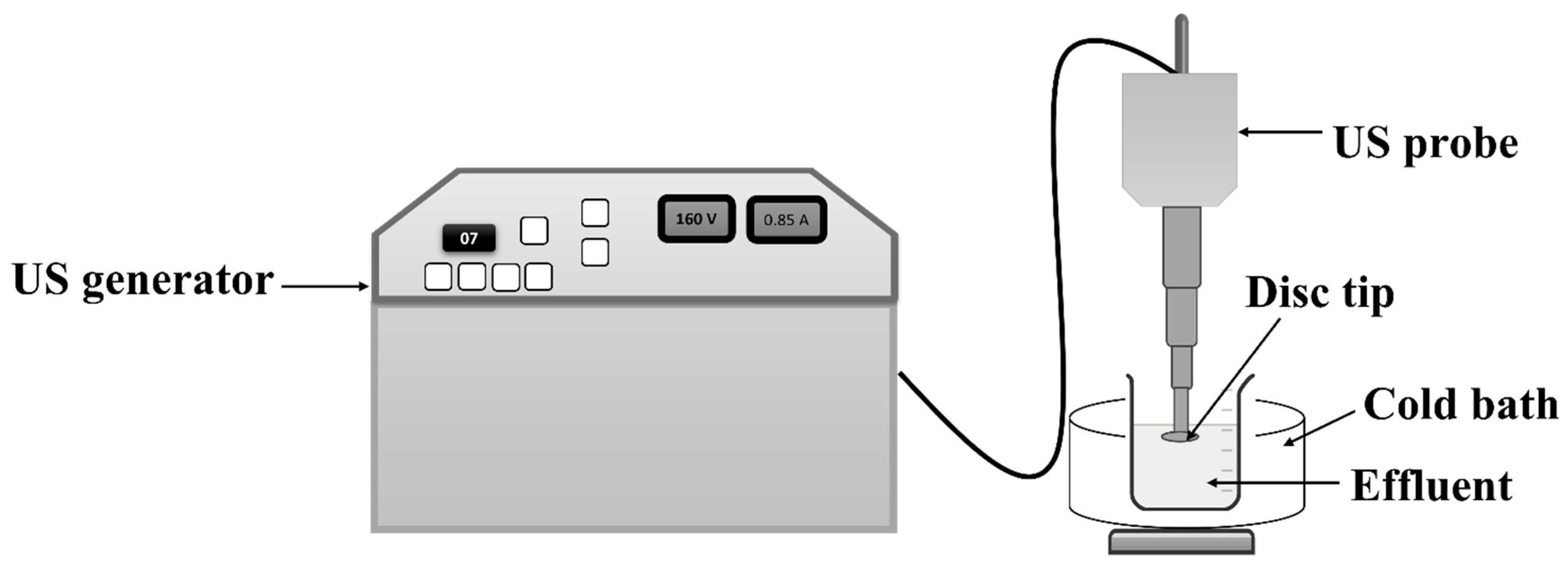
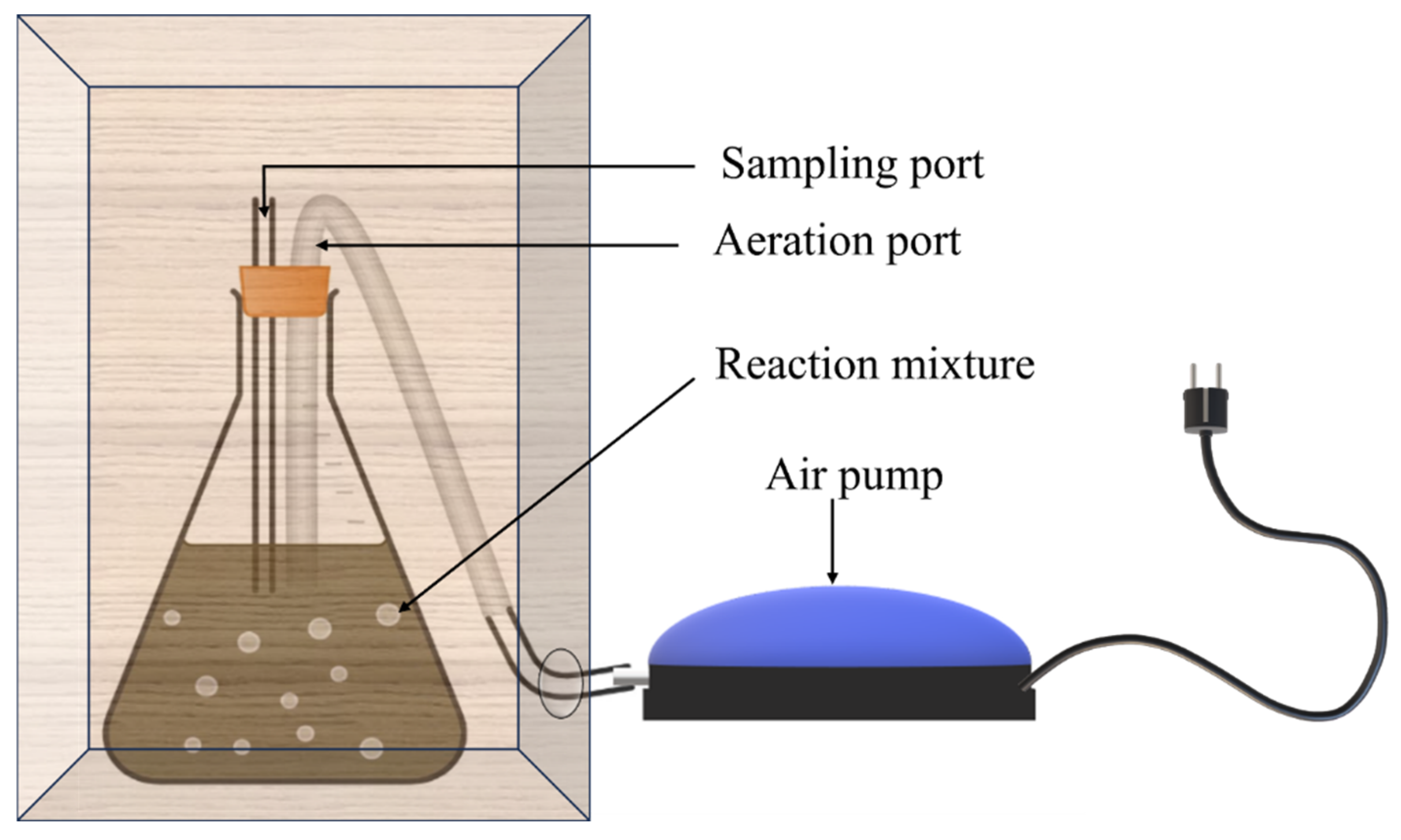







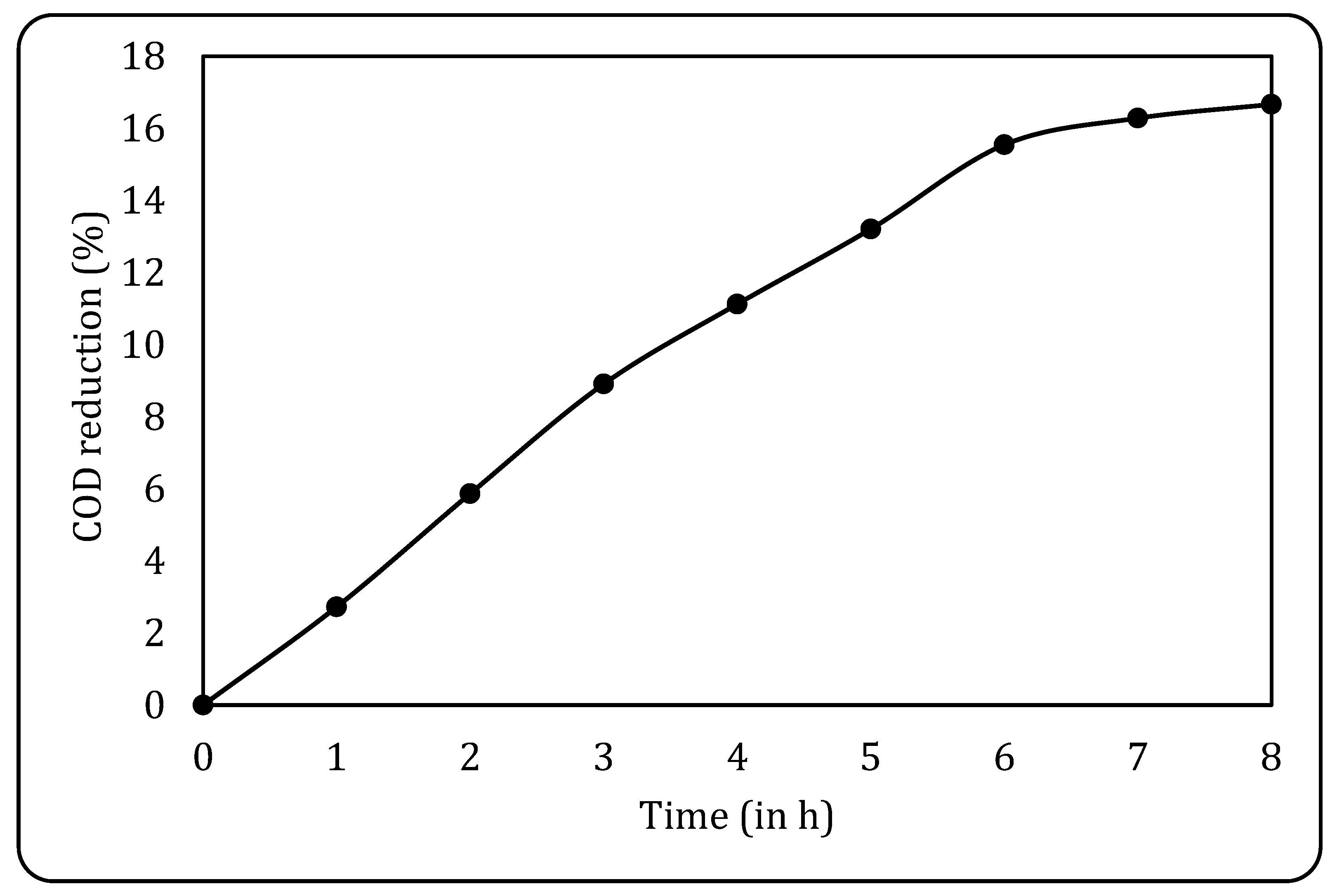

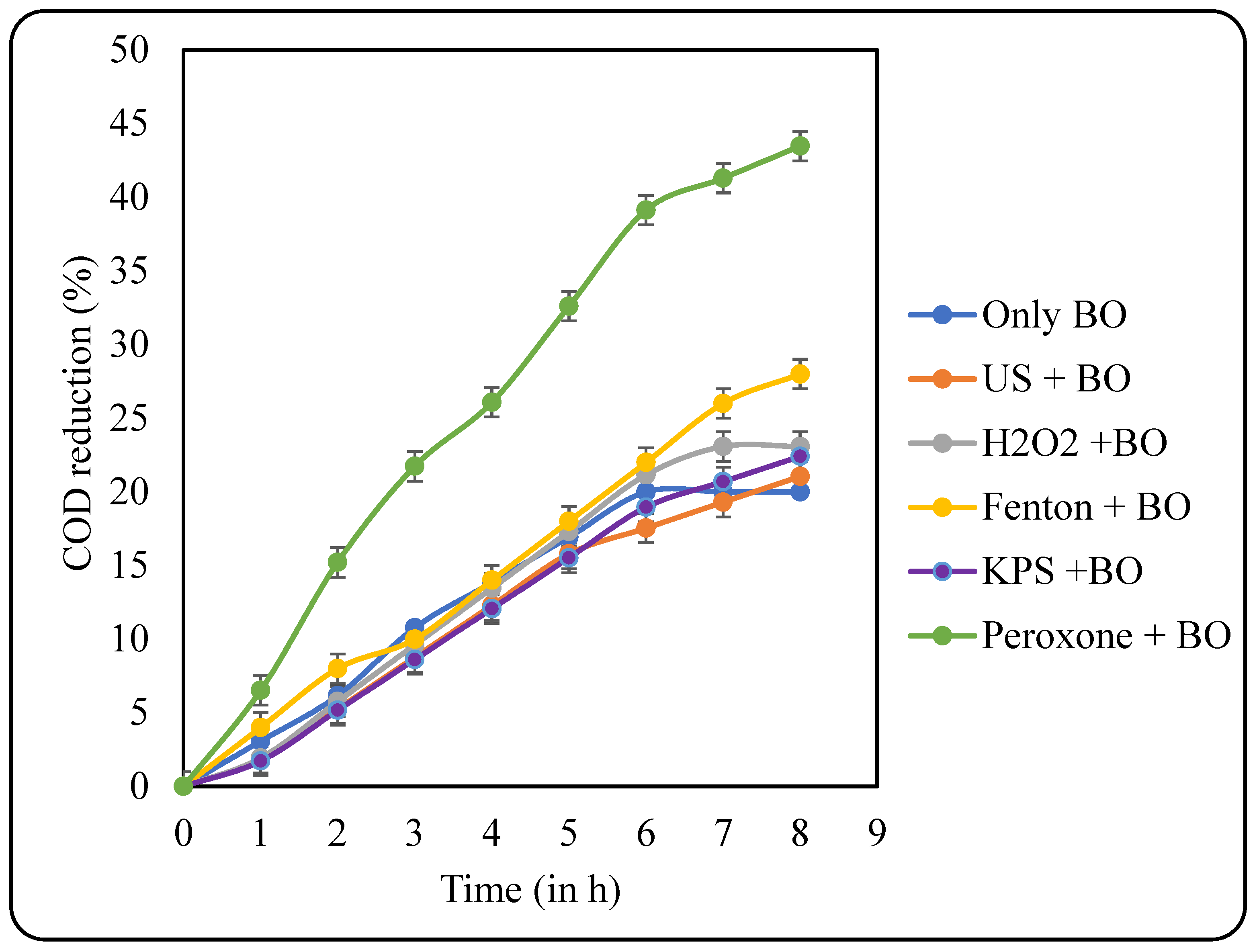
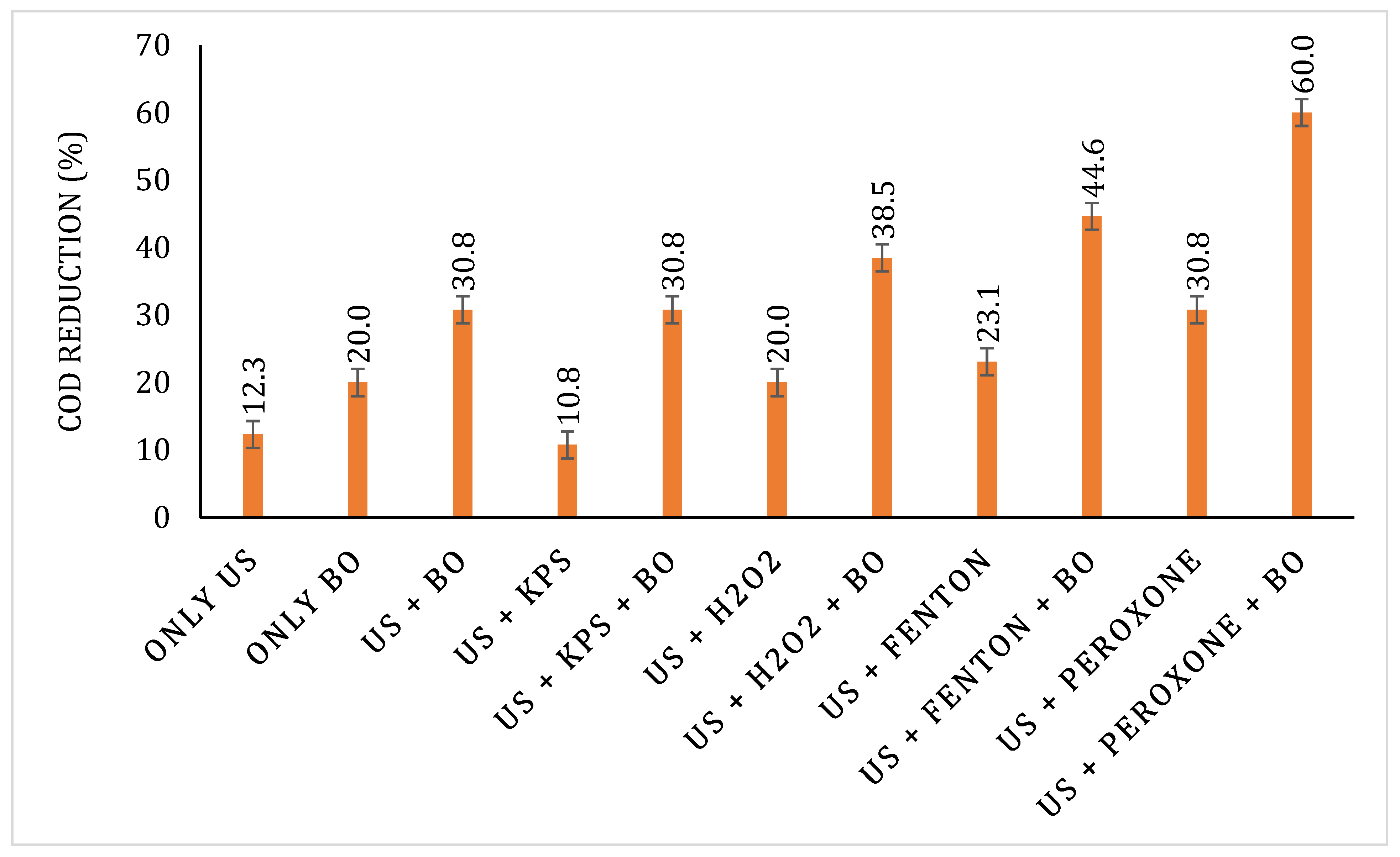
| pH | 12 ± 0.5 |
| Initial COD | 3200 ± 100 ppm |
| TDS | 4000–5000 ppm |
| Appearance | Clear pale–yellow solution with suspended particles |
| Odor | Pungent |
| Method | COD Reduction (%) | Rate Constant (k) | Correlation Coefficient (R2) |
|---|---|---|---|
| US | 12.31 | 0.0011 | 0.999 |
| US + KPS | 10.77 | 0.002 | 0.99 |
| US + H2O2 | 20 | 0.0037 | 0.999 |
| US + Fenton | 27.69 | 0.0043 | 0.998 |
| US + Peroxone | 30.77 | 0.0057 | 0.994 |
| Sample | Zone of Clearance (in mm) |
|---|---|
| Raw effluent | 5 |
| Positive Control | 24 |
| Negative Control | 0 |
| US | 4 |
| US + KPS | 4 |
| US + H2O2 | 4 |
| US + Fenton | 3 |
| US + Peroxone | 3 |
| (a) Colony Characteristics | |
| Surface | Opaque |
| Colour | White |
| Shape | Round |
| Texture | Mucoid |
| Elevation | Flat |
| Edge | Entire |
| Gram nature | Positive |
| (b) Colony Characteristics | |
| Surface | Glistening |
| Colour | Cream |
| Shape | Ovoid |
| Texture | Smooth |
| Elevation | Flat |
| Edge | Entire |
| Gram nature | Negative |
| Treatment Method | Pretreatment COD Reduction (%) | Overall COD Reduction (%) | Overall Yield (×10−4) (mg/J) | Energy (×106 kWh/L) | Total Cost (Rs)/Litre |
|---|---|---|---|---|---|
| BO | 0 | 12.31 | 8.67 | 3.6 | 8.78 |
| US | 12.31 | 30.77 | 8.01 | 3.89 | 9.5 |
| US + KPS | 10.77 | 30.77 | 8.68 | 3.6 | 8.85 |
| US + H2O2 | 20 | 38.46 | 8.02 | 3.89 | 10.5 |
| US + Fenton | 23.08 | 44.62 | 9.36 | 3.33 | 9.18 |
| US + Peroxone | 30.77 | 60 | 13.4 | 2.33 | 8.81 |
Disclaimer/Publisher’s Note: The statements, opinions and data contained in all publications are solely those of the individual author(s) and contributor(s) and not of MDPI and/or the editor(s). MDPI and/or the editor(s) disclaim responsibility for any injury to people or property resulting from any ideas, methods, instructions or products referred to in the content. |
© 2025 by the authors. Licensee MDPI, Basel, Switzerland. This article is an open access article distributed under the terms and conditions of the Creative Commons Attribution (CC BY) license (https://creativecommons.org/licenses/by/4.0/).
Share and Cite
Iyer, A.M.; Karande, A.V.; Gogate, P.R. Treatment of Pharmaceutical Effluent Using Ultrasound-Based Advanced Oxidation for Intensified Biological Oxidation. Processes 2025, 13, 1191. https://doi.org/10.3390/pr13041191
Iyer AM, Karande AV, Gogate PR. Treatment of Pharmaceutical Effluent Using Ultrasound-Based Advanced Oxidation for Intensified Biological Oxidation. Processes. 2025; 13(4):1191. https://doi.org/10.3390/pr13041191
Chicago/Turabian StyleIyer, Akshara M., Aditya V. Karande, and Parag R. Gogate. 2025. "Treatment of Pharmaceutical Effluent Using Ultrasound-Based Advanced Oxidation for Intensified Biological Oxidation" Processes 13, no. 4: 1191. https://doi.org/10.3390/pr13041191
APA StyleIyer, A. M., Karande, A. V., & Gogate, P. R. (2025). Treatment of Pharmaceutical Effluent Using Ultrasound-Based Advanced Oxidation for Intensified Biological Oxidation. Processes, 13(4), 1191. https://doi.org/10.3390/pr13041191







